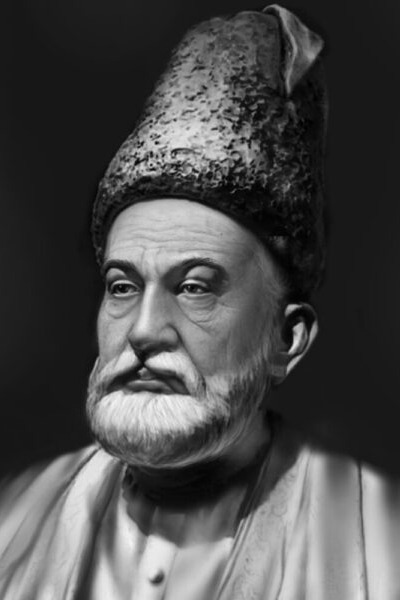
Personal info
Known for
Ultimate Talent
Gender
Male
Birthday
27 December
Location
Uttar Pradesh, India
Edit pageMirza Ghalib
Biography
Mirza Ghalib, born as Mirza Asadullah Baig Khan on December 27, 1797, in Agra, India, is one of the most celebrated and revered poets in Urdu and Persian literature. Ghalib's early life was marked by the tragic loss of his father and uncle at a young age, forcing him to mature quickly and face the harsh realities of life. Raised in a well-to-do family, he was able to receive a good education and was trained in Persian, Arabic, and classical poetry.
Ghalib was married at a young age to the daughter of a nobleman, but the marriage was not particularly happy. His personal life was marked by financial difficulties and the early death of his children, which left him with deep emotional scars. Despite these hardships, his poetic talent flourished, and his ability to translate complex emotions into words became his hallmark.
Poetic Career:
Mirza Ghalib’s poetry is widely regarded for its intricate beauty, depth of emotion, and exploration of love, loss, pain, and the complexity of the human soul. Though he wrote in both Persian and Urdu, it was his contributions to Urdu poetry that earned him a place as one of the greatest poets in the language.
Ghalib's poetry stands out for its innovative use of language and the fusion of classical Persian influences with the emerging style of Urdu poetry. He was known for his ghazals, a form of poetry that expresses the pain of love, longing, separation, and the existential struggles of life. His ghazals transcend mere romantic themes and often delve into the spiritual, intellectual, and philosophical realms.
Some of his most famous ghazals include "Hazaaron Khwahishen Aisi," "Dil Hi To Hai," "Na Tha Kuch To Kuch Bhi Nahi Tha," and "Yeh Na Thi Hamari Qismat." These works continue to be cherished by readers and listeners alike for their lyrical grace, metaphysical depth, and emotional intensity.
Philosophical and Spiritual Themes:
In addition to his personal experiences of heartbreak and loss, Ghalib’s work is known for its philosophical and spiritual undertones. His poetry reflects a deep questioning of life, love, destiny, and the nature of God. His ghazals often express his inner conflict with the divine, as well as his reflections on the transitory nature of life.
Ghalib’s famous line, "Hazaaron Khwahishen Aisi, Ke Har Khwahish Pe Dam Nikle," is a perfect example of his ability to capture the pain and beauty of unfulfilled desires. His verses oscillate between despair and hope, often portraying the complex interplay between love and suffering.
Role in Urdu Literature:
Mirza Ghalib’s influence on Urdu literature cannot be overstated. Though he was not immediately appreciated by his contemporaries, today he is regarded as one of the most important poets of the 19th century. His unique style of combining Persian and Urdu, his ability to speak to both the intellectual and emotional aspects of the human condition, and his literary genius have cemented his place in history.
Ghalib’s work also marks a turning point in the development of Urdu poetry. His romanticism, intellectualism, and mastery over poetic forms have left a lasting impact on the subsequent generations of poets. His poetry, filled with wit, sorrow, and yearning, became the model for countless other poets, and his legacy endures through modern-day ghazals, music, and literature.
Personal Life and Struggles:
Ghalib’s life was marked by personal hardship and struggle. Though he received recognition for his poetry, his financial situation was often precarious. At one point, he even went to the court of the Mughal emperor Bahadur Shah Zafar to seek patronage. His relationship with the emperor was cordial, and Ghalib became a prominent figure in the Mughal court.
However, the Indian Rebellion of 1857, during which the British crushed the Mughal Empire, led to political and social upheaval. Ghalib witnessed these turbulent events firsthand, and the loss of the Mughal court’s patronage added to his financial woes. Despite these challenges, Ghalib continued to write prolifically, and his personal sorrows were often reflected in his work.
Ghalib’s later years were marked by deteriorating health, and he passed away on February 15, 1869, in Delhi. His legacy, however, lived on through his poetry, which has inspired generations of writers, musicians, and lovers of literature.
Legacy and Influence:
Mirza Ghalib’s poetry continues to resonate with audiences worldwide, transcending cultural and linguistic boundaries. His ghazals have been immortalized through countless renditions in classical and contemporary music, and his influence extends far beyond the realm of literature. Ghalib's words speak to the universal human experience of love, loss, and the search for meaning in a complex world.
In modern-day Pakistan and India, Ghalib’s works are still taught in schools, recited in mushairas (poetry gatherings), and quoted by people from all walks of life. His poetry has been adapted into films, songs, and stage performances, and his name remains synonymous with the beauty and emotional depth of Urdu poetry.
Conclusion:
Mirza Ghalib’s life and work remain a testament to the power of words to capture the human experience in its fullest, most poignant form. His blend of intellectual rigor, emotional vulnerability, and spiritual depth has made him a towering figure in world literature. Through his timeless ghazals and reflections on life, Ghalib continues to touch the hearts of readers and listeners, cementing his place as one of the greatest poets of all time.